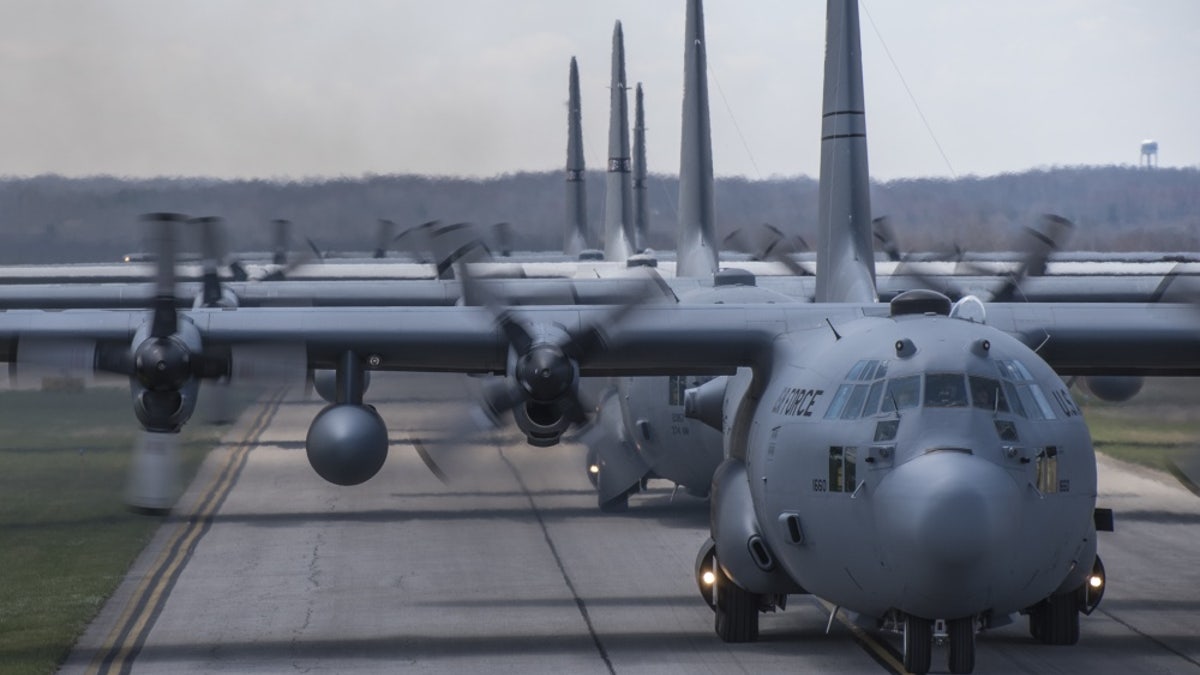
File photo - The 179th Airlift Wing conducts a five ship formation flight using five of their eight C-130H Hercules to conduct coordinated airdrops, April 26, 2018. As the unit's first five ship formation since the conversion back to the C-130H, the flight allowed members of maintenance, aerial port and operations groups to work together increasing overall readiness of deployable assets. (U.S. Air National Guard photo by Tech. Sgt. Joe Harwood/RELEASED)
The Air Force plans to fly its war-tested 1950s-era C-130 aircraft well into the 2030s and beyond through a sweeping, multi-pronged technical overhaul, designed to enable the propeller-flown aircraft to perform its high-risk troop transport and combat support missions for decades to come.
While there have been many innovations, upgrades and technological enhancements to the aircraft since it originally surfaced in the mid-1950s, the historic cargo plane may wind up flying for more than 80 years, according to current Air Force plans.
The service is giving the platform new propeller technology, radios, glass cockpit touchscreen displays, digital avionics, collision avoidance technology and reinforced "wing-boxes," service officials said.
The airframes themselves are a key focal point of the effort, Air Force developers explain, which includes replacing and reinforcing the “center wingbox” of the aircraft where the wings mount to the fuselage.
“The C-130 center wing box replacement program replaces time-limited center wing boxes on applicable variants of the C-130s. Center wing box installations are underway at Warner Robins Air Logistics Center for legacy C-130s and C-130Js as flight hours require,” Maj. Emily Grabowski, Air Force spokeswoman, told Warrior Maven.
As for when a C-130 needs maintenance upgrade to preserve and maintain service life, the Air Force uses an assessment metric referred to as “equivalent baseline hours.” The wing-boxes are changed once the aircraft reaches a certain “severity factor” in its operational service time.
This is necessary because the wear and tear or impact of missions upon and airplane can vary greatly depending upon a range of factors such as the altitude at which a plane is flying, Air Force weapons developers said.
“Low-level flight may be three to four times the severity factor of flying at a higher level,” one senior Air Force official told Warrior.
Called an Avionics Modernization Program by Air Force developers, the upgrades also include adding new 8.33 radios to the aircraft to improve communication and initiatives to upgrade cockpit voice recorders and digital data recorders. C-130s will also receive new collision-avoidance technology designed to prevent the planes from hitting terrain or colliding with one another mid-air
As a propeller-driven aircraft, the C-130s are able to fly at low altitudes, land in more rugged conditions and withstand harsh weather such as obscurants. The propellers make the aircraft’s engines less susceptible to debris flying in and causing operational problems for the engines.
An Air Force C-17, by contrast, needs to operate in more defined conditions, such as areas with longer, separated or unobstructed runways. Flying debris or uneven terrain could of course present complications for C-17 engines, whereas the C-130 is specifically designed for low-altitude, high risk combat zones with uneven terrain – scenarios requiring both durability and maneuverability. In fact, in so-called “hot” or active combat zones, C-130s often airdrop weapons, supplies and even troops when called upon by Commanders.
These factors inform a large part of the calculus for the ongoing Air Force effort to replace the C-130s existing hydromechanical propeller control system with a new Electronic Propeller Control System (EPCS).
Electronic Propeller Control System modification is underway for all C‑130Hs, Grabowski said.
“The T-56 3.5 engine, 8-bladed propeller, and EPCS are undergoing operational test and evaluation at Eglin Air Force Base, Florida. These modifications were tested individually and are now undergoing test together to determine their combined operational effectiveness,” she added.
An essay written by the National Guard Association of the United States further elaborates upon the merits of moving to electronic propeller control systems.
“EPCS improves safety by accelerating response time when throttles are rapidly advanced; an issue in previous mishaps. The legacy propeller control system uses 1950’s technology and is a significant maintenance cost driver,” a 2015 National Guard Association “C-130 Propulsion Upgrade” paper for Congress states.
Acceleration improvements such as this naturally bring tactical advantages as well; more maneuverable aircraft better able to handle and accelerate are less vulnerable to enemy ground missile attacks.
“EPCS kits replace 54H60 propeller mechanical controls with a system based on digital computer software, offering improved reliability, and more precise performance. EPCS represents a 50-year leap in prop control technology for C-130 operators with the 54H60 propellers,” a statement from EPCS-maker Hamilton Sundstrand states.
The original 1999 US Patent Application for Electronic Propeller Control Systems, submitted through United Technologies by a small group of inventors, explains that the new electrical system improves the mechanisms controlling the “pitch angle” of a propeller blade. This improves maneuverability, creates faster acceleration from the throttle and optimizes the connectivity between the propeller controls and the movements of the propeller blades. A stable pitch angle, described as the angle between the horizontal and vertical axes of the aircraft, is essential to aircraft performance and flight stability.
“The apparatus converts mechanical inputs of the propeller and airframe systems to electronic signals, which can be measured by the electronic control. The apparatus also receives and converts the electronic control's commands into hydraulic pressure and flow changes through an electro-hydraulic servo valve,” the Patent Abstract writes.
More Weapons and Technology - WARRIOR MAVEN (CLICK HERE)




















